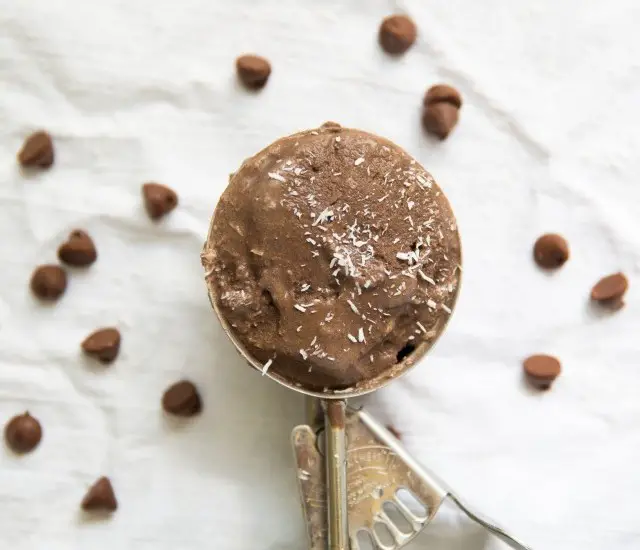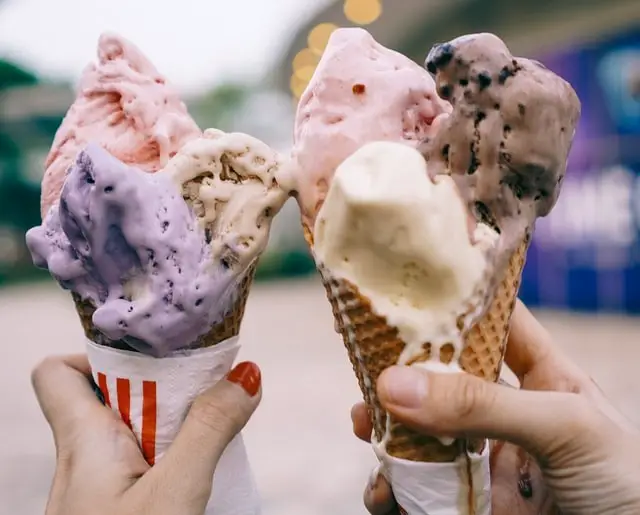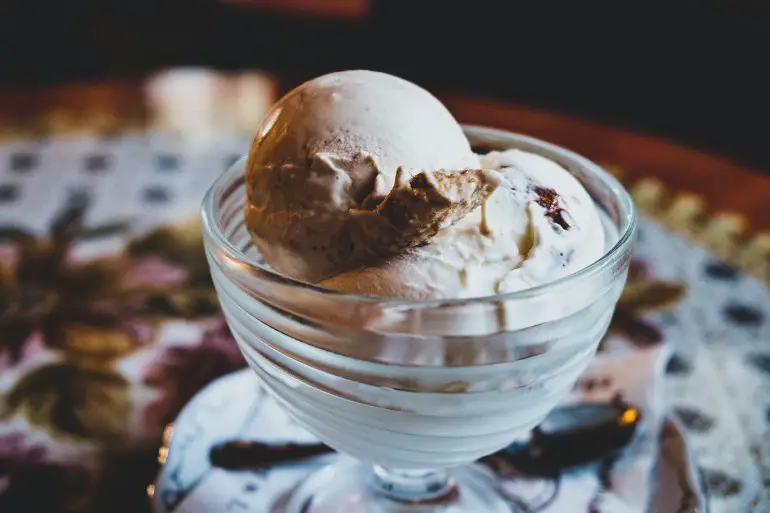1. The Problem: Ice Cream Base has Curdled or Separated
The eggs in the ice cream base will begin to set and thicken the mixture around 160 to 180 degrees Fahrenheit which is far below the boiling point of 212 degrees Fahrenheit (boiling point gets closer to 200 degrees the higher your elevation). To prevent eggs from scrambling in the base, cook over low heat and stir constantly.
How to Fix It:
If your mixture starts to bubble or boil, then quickly remove it from the heat and place the bottom of the saucepan in a bowl of ice water. Whisk vigorously to quickly cool down the mixture and prevent it from curdling.
If your mixture has already started to cool and separate a bit, or it seems to have small bits of cooked egg throughout, you can probably still fix it! As long as the flavor is still good, simply blend the mixture. If you have an immersion blender, you can blend the mixture while hot; otherwise, allow it to cool down before blending. Then pour the mixture through a strainer once or twice to make sure and remove any solid egg bits. Your ice cream base should now be smooth, creamy, and you’re good to go!
2. The Problem: Ice Cream is Greasy or has Clumps of Fat
If your ice cream is starting to look more like butter, it is likely due to the ice cream having too much fat in it or from it being over-churned. Homemade ice cream will never churn to the firm consistency we see in store-bought ice cream. It is done churning once it is soft-serve consistency. Then it will need to finish firming up in the freezer.
How to Fix It:
Make sure you are using a good ice cream recipe and that you haven’t substituted ingredients and added additional fat. If your ice cream is over-churned, it can be fixed by placing it in the fridge. Allow it to melt fully, then rechurn.

3. The Problem: Ice Cream is Gritty or Icy
Gritty texture can be due to the sugar not fully having dissolved in your ice cream base. Be sure to taste your ice cream base before churning to ensure the sugar has fully dissolved.
Icy texture can also be due to over-churning. Ice crystals begin to form during the churning process. This is what gives ice cream its texture. However, if you churn for too long, the crystals continue to get bigger and can give your ice cream an icy texture. Ice cream will also get larger ice crystals the longer it is stored in the freezer.
How to Fix It:
If your ice cream has been over-churned, the best fix is to let the ice cream melt in the fridge and then rechurn the mixture. Watch your ice cream closely; it is finished when it is at a soft-serve texture. It will finish firming up in the freezer.
Make sure that if you’re using a machine with a freezing bowl, make sure it is completely frozen (freeze 12+ hours). If your ice cream machine uses ice and salt to freeze the ice cream, ensure your metal bowl is very cold (place it in the freezer for at least 15-30 minutes). Also, make sure that you have plenty of ice and salt in the ice cream machine.
To prevent your ice cream from becoming icy in the freezer, be sure to eat your ice cream as fresh as possible. It can also help store it with plastic wrap pressed into the top in airtight, single-serve containers. Single-serve containers prevent your ice cream from melting and refreezing every time the container is removed from the freezer.
If rechurning your ice cream is not an option, try turning your ice cream into a milkshake. Blend it with fruit, peanut butter, caramel, etc., and a splash of milk. This will help remove the icy texture.
4. The Problem: Ice Cream isn’t Freezing.
If your bowl isn’t cold enough, your ice cream may not freeze. A hot or warm ice cream base will also slow or prevent your ice cream from freezing.
If you have substituted lower-fat milk in then, your ice cream may not freeze as quickly or at all. Decreasing the fat in your ice cream will also affect the texture. If you have added alcohol to your ice cream, that may also prevent it from freezing. Be careful when making substitutions or adding things to your ice cream base.
How to Fix It:
Homemade ice cream will not churn to the consistency of store-bought ice cream. It will be a soft-serve consistency. If your ice cream is soft-serve texture, place it in the freezer for 2-4 hours to fully firm up.
If your mixture is not a soft-serve texture but still liquid and doesn’t appear to be thickening up after 30-45 minutes, you may have a problem. Your mixture may not be have been cold enough, or the bowl not chilled fully. If you are using a machine that needs ice and salt, you may need to add more ice and/or salt.

5.The Problem: Ice Cream Melts Too Quickly
Homemade ice cream melts more quickly than store-bought ice cream. This is for several reasons. Store-bought ice cream contains added stabilizers (such as tapioca flour, carrageenan, or guar gum); homemade ice cream usually only has eggs as a stabilizer. In addition, ice cream with more overrun (more air incorporated into the ice cream during churning) melt more slowly. Homemade ice cream typically has less overrun and melts more quickly.
The Fix:
Freeze your homemade ice cream in single-serving containers, so the whole container isn’t melting while you are scooping out the ice cream you need. If you want to make ice cream that doesn’t melt quickly, you can play around with adding solids or stabilizers to your ice cream. For that, I recommend checking out this dreamscoops article.
Need a great ice cream recipe? Check out my Five Best Ice Cream Maker Recipes. If you’re interested in learning more about ice cream, check out my Brief History of Ice Cream.






